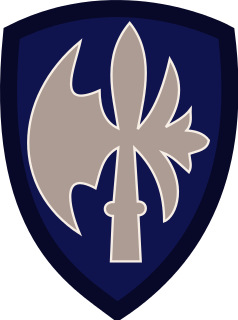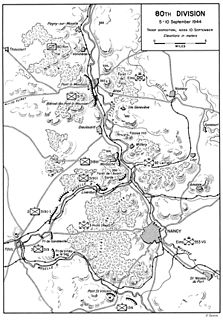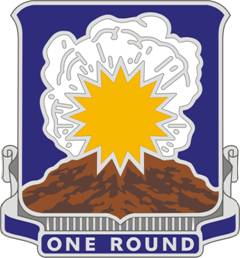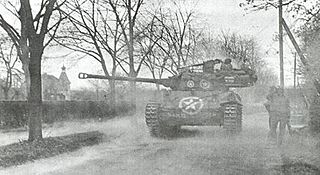
The 6th Armored Division was an armored division of the United States Army during World War II. It was formed with a cadre from the 2nd Armored Division.

The 7th Armored Division was an armored division of the United States Army that saw distinguished service on the Western Front, from August 1944 until May 1945, during World War II.

The 10th Armored Division was an armored division of the United States Army in World War II. In the European Theater of Operations the 10th Armored Division was part of both the Twelfth United States Army Group and Sixth United States Army Group. Originally assigned to the Third United States Army under General George S. Patton, it saw action with the Seventh United States Army under General Alexander Patch near the conclusion of the war.

The 65th Infantry Division—nicknamed the "Battle-Axe Division"—was an infantry division of the United States Army that served in World War II. Its shoulder patch is a white halberd on a blue shield.

The 95th Infantry Division was an infantry division of the United States Army. Today it exists as the 95th Training Division, a component of the United States Army Reserve headquartered at Fort Sill, Oklahoma.

The 90th Infantry Division was a unit of the United States Army that served in World War I and World War II. Its lineage is carried on by the 90th Sustainment Brigade.

The Battle of Nancy in September 1944 was a 10-day battle on the Western Front of World War II in which the Third United States Army defeated German forces defending the approaches to Nancy, France and crossings over the Moselle River to the north and south of the city. The battle resulted in U.S. forces fighting their way across the Moselle and liberating Nancy.

The Colmar Pocket was the area held in central Alsace, France, by the German Nineteenth Army from November 1944 to February 1945, against the U.S. 6th Army Group during World War II. It was formed when 6th AG liberated southern and northern Alsace and adjacent eastern Lorraine, but could not clear central Alsace. During Operation Nordwind in December 1944, the 19th Army attacked north out of the Pocket in support of other German forces attacking south from the Saar into northern Alsace. In late January and early February 1945, the French First Army cleared the Pocket of German forces.

The XX Corps of the United States Army fought from northern France to Austria in World War II. Constituted on 10 October 1943 by re-designating the IV Armored Corps of the Army Ground Forces, a training organization which had been activated at Camp Young, California on 5 September 1942, XX Corps became operational in France as part of Lieutenant General George S. Patton's U.S. Third Army on 1 August 1944.

The 602nd Tank Destroyer Battalion was a tank destroyer battalion of the United States Army active during the Second World War.

The 603rd Tank Destroyer Battalion was a tank destroyer battalion of the United States Army active during World War II.
The 605th Tank Destroyer Battalion was a tank destroyer battalion of the United States Army active during World War II.
The 607th Tank Destroyer Battalion was a tank destroyer battalion of the United States Army active during the Second World War. They arrived in England during April, 1944, and entered combat in mid June, landing at Utah Beach. The unit fought across France and into Germany during the summer and early winter of 1944. In late winter, they were then pulled out and sent to Belgium near the end of the Ardennes Campaign and again fought their way into and across Germany, ending the war near the Czechoslovakian border. The 607th received credit for the Normandy, Northern France, Rhineland, Ardennes-Alsace and Central Europe campaigns.

The 818th Tank Destroyer Battalion was a tank destroyer battalion of the United States Army active during World War II. It first saw combat in July 1944, when it deployed into the Normandy beachhead in preparation for the breakout into France by Lieutenant General George Patton's Third Army. Working closely with the 5th Infantry Division, it moved through northern France up to the Moselle region, where it was involved in the Battle for Metz through September, October and November. In December, it disengaged from defensive positions along the German border and was moved north to fight in the Battle of the Bulge with the 26th Infantry Division. After securing the Allied flanks and mopping up the Bulge, it refitted for two months before fighting south along the Siegfried Line and crossing the Rhine in March. In April and early May, it rushed through southern Germany into Austria and Czechoslovakia, where it ended the war. After a brief spell of occupation duties, it was returned to the United States and disbanded in November. During the European campaign, the battalion lost a total twenty-six men and eight tank destroyers in combat.
The 628th Tank Destroyer Battalion was a tank destroyer battalion of the United States Army active during the Second World War. It was redesignated the 628th Tank Battalion after the end of the war, and today exists as the 103rd Armor Regiment.

The 643rd Tank Destroyer Battalion was a tank destroyer battalion of the United States Army active during the Second World War.

The 705th Tank Destroyer Battalion was a tank destroyer battalion of the United States Army active during the Second World War. It was originally formed from artillery elements of the 5th Armored Division, and its lineage is today perpetuated by the 75th Cavalry Regiment.

The Battle of Frankfurt was a four-day struggle for control of Frankfurt am Main during World War II. The 5th Infantry Division conducted the main attack while the 6th Armored Division provided support. The city was defended by the LXXX Corps of the Seventh Army.

The 824th Tank Destroyer Battalion was a tank destroyer battalion of the United States Army active during the Second World War. It saw service during 1944–45 in the European Theater of Operations, primarily attached to the 100th Infantry Division in an infantry support role. After fighting through France and southern Germany, the battalion ended the war in Austria.
The 735th Tank Battalion was an independent tank battalion that participated in the European Theater of Operations with the United States Army in World War II. The battalion entered combat in Normandy in July 1944 with the 5th Infantry Division and fought across France with the 95th Infantry Division. When reattached to the 5th Infantry Division, the 735th Tank Battalion played a key role in the reduction of the fortifications of Metz. The battalion was also attached to the 26th Infantry Division during the Battle of the Bulge and fought the last several months of the war attached to the 87th Infantry Division. It was inactivated in October 1945.



















